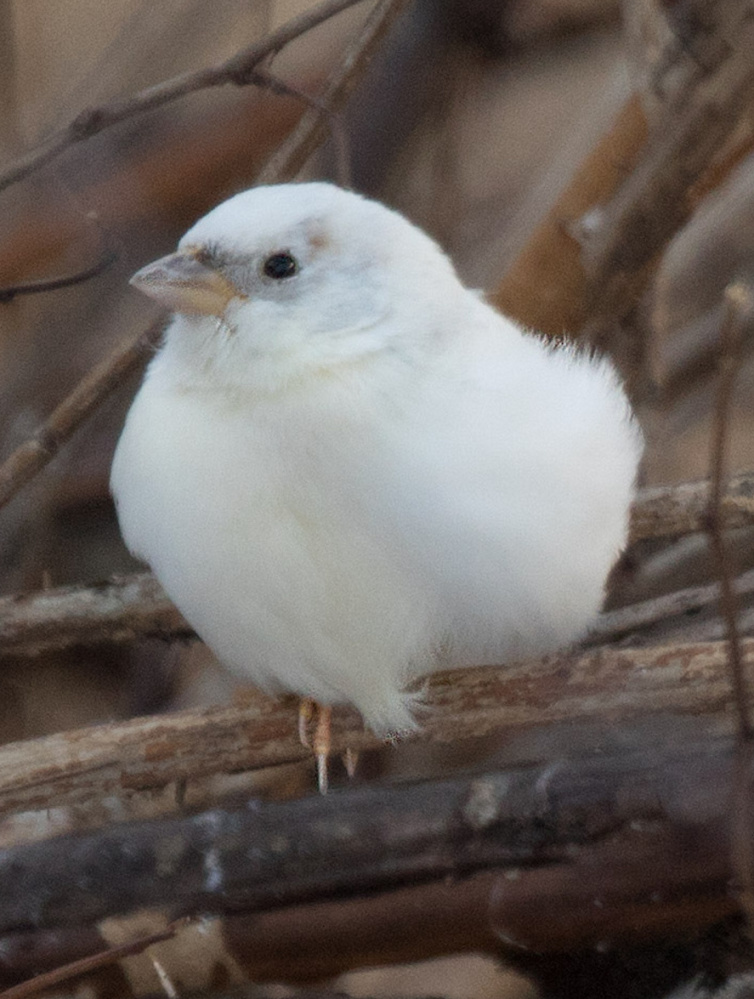A snowball of a house sparrow has been frequenting Peggy Blair’s feeders in Clinton for the past four years. A number of birders got to see this sparrow as they made the trek to Peggy’s feeders to see two dickcissels that spent two weeks there starting in late November.
The sparrow has been the subject of a lot of discussion among birders. Is it an albino? A partial albino? A leucistic bird? I thought the white house sparrow would provide a good jumping-off point for a discussion of aberrant plumages in birds.
In college, I had a professor who said that nature has no interest in being classified. To be sure, trying to pigeon-hole odd plumages of birds is fraught with problems.
Nonetheless, Han van Grouw took a crack at classifying different kinds of aberrantly white-plumaged birds.
To start, we need to know that two major types of feather pigments occur in birds. Carotenoids are the feather pigments that make some birds so colorful. These pigments vary from pale yellow to scarlet red. Birds cannot make carotenoids but rather acquire them from their diet. Flamingos’ pink is produced by carotenoids from the small shrimp the birds prefer.
Melanins provide the blacks, grays, dark browns and reddish browns in feathers. Birds are able to synthesize their own melanin using the amino acid tyrosine, one of the constituents of proteins.
Let’s start with albinism. An albino bird lacks the enzyme tyrosinase and so is unable to convert tyrosine to melanins. An albino bird will have no black or brown feathering on the body at all. Further, the eyes and skin are colorless. They appear red because of the blood that can be seen through the skin.
Peggy’s white house sparrow is clearly not an albino. The eyes are dark and you can see some black feathering on the head. This bird is clearly capable of making melanins.
Albinism is actually one of the least common aberrant white plumages. And here’s a fact to bend your mind: It is possible to have a bird like a summer tanager with beautiful red plumage that is an albino. If the bird cannot produce melanins, it can still acquire carotenoids from its diet to make red feathers. But it will have colorless skin and eyes. So a male summer tanager with red eyes is albino.
The life span of an albino is usually much shorter than average. The reason is bad vision. The lack of eye pigments means that albinos are extremely light-sensitive and have poor depth perception.
The phrase “partial albino” is frequently applied to birds from colorful species with some but not all white feathering. I agree with van Grouw that this phrase needs to be stricken from our vocabulary. If a bird can produce some melanin, like our house sparrow, it is not an albino. “Partial albino” is self-contradictory.
Leucism describes the condition in which some or all of a bird’s feathers lack melanins. A leucistic bird can synthesize melanins but lacks the ability to transfer the melanin to its feathers. This description fits our house sparrow perfectly. We know that the bird can produce melanins because the eyes are dark and a few dark feathers appear on the head.
Leucism can vary – from fewer than a quarter of the feathers being white to totally white feathers. A leucistic bird does not have the defective eyesight of an albino so its expected life span is not shortened.
I’ve just touched the surface of aberrant plumages here. Some birds appear to have washed-out feathers, but not white. Reductions in the quality (brown mutation) or quantity (dilution) can yield abnormally light-colored birds. Some birds overproduce melanin (melanism) and appear much darker than normal. And yes, there can be shades of gray.
Herb Wilson teaches ornithology and other biology courses at Colby College. He welcomes reader comments and questions at
whwilson@colby.edu.
Copy the Story LinkSend questions/comments to the editors.



Success. Please wait for the page to reload. If the page does not reload within 5 seconds, please refresh the page.
Enter your email and password to access comments.
Hi, to comment on stories you must . This profile is in addition to your subscription and website login.
Already have a commenting profile? .
Invalid username/password.
Please check your email to confirm and complete your registration.
Only subscribers are eligible to post comments. Please subscribe or login first for digital access. Here’s why.
Use the form below to reset your password. When you've submitted your account email, we will send an email with a reset code.